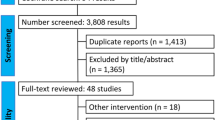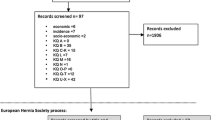Abstract
Background
Prosthetic meshes give excellent results in groin hernia repair. However, although recurrence rates are very low, chronic pain remains frequent and mesh fixation may play a role in the occurrence of this complication. The use of fibrin sealant to secure the mesh may represent a useful alternative for the prevention of chronic pain. The aim of this study is to confirm that the mesh may be secured by spraying fibrin sealant and to assess the reduction in the incidence of chronic pain.
Methods
Seventy hernias were operated on in 57 patients and were evaluated on a prospective basis. The procedure involved placement of a plug and patch mesh which was secured with fibrin sealant alone. These patients were compared to a matched retrospective series of 57 patients who underwent the same procedure, except that conventional non-absorbable suture was used to secure the mesh.
Results
The two groups were equivalent for inclusion criteria and preoperative data. The complication rate was similar in the two groups. The operative time was shorter in the fibrin sealant group: 7 min for unilateral hernia (p = 0.0017) and 16 min for bilateral hernia (p = 0.0008). The length of hospital stay was also shorter in the fibrin sealant group (1.8 days vs. 2.5 days: p < 0.0001). There was no recurrence in the fibrin sealant group after a minimum follow-up of 12 months and no recurrence in the suture group after a minimum follow-up of 25 months. Finally, a significant reduction in chronic pain was observed in the fibrin sealant group (3.5% vs. 22.8%: p = 0.042).
Conclusion
This study confirms the effectiveness of fibrin glue in securing prosthetic meshes and reducing chronic inguinal pain.

Similar content being viewed by others
References
Rutkow IM (2003) Demographic and socioeconomic aspects of hernia repair in the United States in 2003. Surg Clin North Am 83(5):1045–1051
Sachs M, Damm M, Encke A (1997) Historical evolution of inguinal hernia repair. World J Surg 21(2):218–223
EU Hernia Trialist Collaboration (2000) Mesh compared with non-mesh methods of open groin hernia repair: systematic review of randomized controlled trials. Br J Surg 87(7):854–859
Poobalan AS, Bruce J, Smith WC, King PM, Krukowski ZH, Chambers WA (2003) A review of chronic pain after inguinal herniorrhaphy. Clin J Pain 19(1):48–54
Nienhuijs SW, Boelens OB, Strobbe LJ (2005a) Pain after anterior mesh hernia repair. J Am Coll Surg 200(6):885–889
Katkhouda N, Mavor E, Friedlander MH, Mason RJ, Kiyabu M, Grant SW, Achanta K, Kirkman EL, Narayanan K, Essani R (2001) Use of fibrin sealant for prosthetic mesh fixation in laparoscopic extraperitoneal inguinal hernia repair. Ann Surg 233(1):18–25
Robbins AW, Rutkow IM (1998) Mesh plug repair and groin hernia surgery. Surg Clin North Am 78(6):1007–1023
Cunningham J, Temple WJ, Mitchell P, Nixon JA, Preshaw RM, Hagen NA (1996) Cooperative hernia study. Pain in the postrepair patient. Ann Surg 224(5):598–602
Bay-Nielsen M, Perkins FM, Kehlet H, Danish Hernia Database (2001) Pain and functional impairment 1 year after inguinal herniorrhaphy a nationwide questionnaire study. Ann Surg 233(1):1–7
Condon RE (2001) Groin pain after hernia repair. Ann Surg 233(1):8
al-dabbagh AK (2002) Anatomical variations of the inguinal nerves and risks of injury in 110 hernia repairs. Surg Radiol Anat 24(2):102–107
Rab M, Ebmer And J, Dellon AL (2001) Anatomic variability of the ilioinguinal and genitofemoral nerve implications for the treatment of groin pain. Plast Reconstr Surg 108(6):1618–1623
Neumayer L, Giobbie-Hurder A, Jonasson O, Fitzgibbons R Jr, Dunlop D, Gibbs J, Reda D, Henderson W, Veterans Affairs Cooperative Studies Program 456 Investigators (2004) Open mesh versus laparoscopic mesh repair of inguinal hernia. N Engl J Med 350(18):1819–1827
Nienhuijs SW, Kortmann B, Boerma M, Strobbe LJ, Rosman C (2004) Preferred mesh-based inguinal hernia repair in a teaching setting: results of a randomized study. Arch Surg 139(10):1097–1100
Kingsnorth AN, Porter CS, Bennet DH, Walker AJ, Hyland ME, Sodergren S (2000) Lichtenstein patch or Perfix plug-and-patch in inguinal hernia: a prospective double-bind randomized controlled trial of short-term outcome. Surgery 127(3):276–283
Nienhuijs SW, van Oort I, Keemers-Gels ME, Strobbe LJ, Rosman C (2005b) Randomized trial comparing the Prolene Hernia System, mesh plug repair and Lichtenstein method for open inguinal hernia repair. Br J Surg 92(1):33–38
Helbling C, Schlumpf R (2003) Sutureless Lichtenstein: first results of a prospective randomized clinical trial. Hernia 7(2):80–84
Canonico S, Santoriello A, Campitiello F, Fattopace A, Corte AD, Sordelli I, Benevento R (2005) Mesh fixation with human fibrin glue (Tissucol) in open tension-free inguinal hernia repair: a preliminary report. Hernia 9(4):330–333
Canonico S (2003) The use of human fibrin glue in the surgical operations. Acta Biomed Ateneo Parmense 74(Suppl 2):21–25
Fernandez Lobato R, Garcia Septiem J, Ortega Deballon P, Martin Lucas FJ, Ruiz de Adana JC, Limones Esteban M (2001) Tissucol application in dermolipectomy and incisional hernia repair. Int Surg 86(4):240–245
Jackson MR (2001) Fibrin sealants in surgical practice: an overview. Am J Surg 182(2 Suppl):1S–7S
Joch C (2003) The safety of fibrin sealants. Cardiovasc Surg 11(Suppl 1):23–28
Author information
Authors and Affiliations
Corresponding author
Rights and permissions
About this article
Cite this article
Benizri, E.I., Rahili, A., Avallone, S. et al. Open inguinal hernia repair by plug and patch: the value of fibrin sealant fixation. Hernia 10, 389–394 (2006). https://doi.org/10.1007/s10029-006-0112-4
Received:
Accepted:
Published:
Issue Date:
DOI: https://doi.org/10.1007/s10029-006-0112-4




